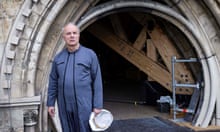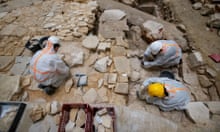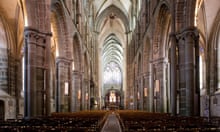In a clearing in a forest in northern Burgundy, the stonemasons and carpenters of Guédelon are awaiting a call.
If anyone can rebuild Notre Dame Cathedral as it was – if that is what is required – they can.
Remaking medieval history is what they have been doing at Guédelon for the past 22 years, as a team of workers and volunteers construct a 13th-century château using the tools and techniques of the epoch and, as far as possible, locally sourced basic materials like stone and wood.
As the fire roared through Notre Dame’s “forest” – its oak-beamed roof – sending flames far into the sky over Paris, many feared something irreplaceable had been lost. Thanks to the heroic efforts of Paris’s firefighters, the essential structure of the magnificent world heritage edifice survived, but the question remained: could it – would it – be restored to its former Gothic glory?
Today, as French officials, heritage experts and architects ponder how this should be done, they are being urged to look 200km down the motorway to where the middle ages live on.
At Guédelon the year is 1250 and the fictional Guilbert Courtenay, a low-ranking aristocrat, has been granted a royal “licence” to build his own château. The aim of what those behind the unique project call “experimental archaeology” is to understand how a 13th-century building was constructed.
Guédelon’s co-founder, Maryline Martin, said if anything good is to come out of the burning of Notre Dame, it is that the traditional trades practised here will finally be recognised as worthwhile.
“Manual trades are not valued; people say if you’re not good at school you’ll end up being a carpenter or a mason. My father worked in the building trade and he tore his hair out at this. I’ve heard this all my life and we have to do something about it,” she said.

“The Notre Dame fire was terrible, like a scene from a Turner painting. It was easy to give up hope and fear there’d be nothing left, but it was the opposite. the Gothic building itself … it stood. The roof beams did their work. They burned and turned to dust and left the building intact. What architect today could say this would happen with one of their buildings?”
France has 40,000 registered historical buildings, some dating back to the middle ages, needing constant maintenance by a dwindling number of artisans specialised in traditional techniques.
Jean-Claude Bellanger, the secretary general of France’s Compagnons du Devoir, a historical artisan guild that engages thousands of apprentices each year, said the country lacks 100 stonecutters, 100 masons, 150 carpenters and at least 200 roofers.
“We have the savoir faire in France to renovate Notre Dame either as it was or with innovation; the real difficulty is the main d’oeuvre, the workers. We don’t have enough young trained people to respond to the demand because manual work is undervalued. But if you learn one of these trades it’s a passport for life,” he said.
Florian Renucci, the Guédelon site manager and a philosopher turned master mason, agrees. “We hope our site can be a window for these noble jobs,” he said. “The trouble with European society is that we have come to consider manual work a failure.”
The idea of transmitting the knowledge of ancient building techniques learned at Guédelon is a philosophy that inspires those who work and volunteer there.
“That is my passion, passing on this heritage to others. We use our heads and our hands, but the truth is that manual work is not given its proper worth,” said Baptiste Fabre, 31, a biologist who retrained as a specialist stonemason and has worked on the castle for six years. “It’s about the pleasure of having done something well with simple materials.”
Away from the main castle, workers in huge wooden hamster wheels attached to pulleys haul stones being used for the entrance towers.
Sandra Lefevre, 40, who gave up her job in human resources for a Paris-based consultancy to become a carpenter, is shaving a large plank of wood with an axe to make a workbench. Like all Guédelon artisans, she is dressed for the middle ages, in a rough tunic and trousers.
“The work here is the most complicated thing I’ve done in my life. Schools never consider manual trades something worthwhile, but you have to work with your head as well as your hands. I have halved my salary but I feel I am much richer,” she said.
Leopold Bigot, 22, is working as a roofer at Guédelon as part of his “tour de France” as a Compagnon de Devoir, which requires him to work on at least two different projects a year.

“Roofing is physical work, not necessarily very well paid, for the danger involved, but we have a future. There will always be a job and work for me and anyone in this trade. It’s a passion for me and we have a saying in France that if your job is your passion, you will never work a day in your life.”
Martin is now planning to set up a trades school at Guédelon offering a fully recognised diploma – a plan in the pipeline even before the Notre Dame fire highlighted a lack of qualified workers. She aims to encourage some of the 80,000 youngsters who visit Guédelon every year to consider careers in the artisan trades.
“We have to do more to create a vocation,” she said. “Notre Dame’s message was we need more stonecutters and masons and carpenters, and it’s an opening for something incredibly positive in the future. We want to work on transmitting what we have learned here.”
Having visited the wooden roof at Notre Dame a few years ago, Renucci would like to see it restored “in the spirit of the Gothic era”.
“And if we do it right there’s no reason it won’t last another 1,000 years,” he said.
As they wait for the call from Paris, the clicking of hand-forged chisels against hand-cut blocks of stone and the hack of axes against wood continue at Guédelon.
Pascal Cluzel, 54, a carpenter since leaving school at 16, was building the roof of a medieval outbuilding.
“If after seeing what we do here, one or two youngsters go away and say: ‘I’d like to be a carpenter’ then we’ve done our job,” he said.
“As for Notre Dame: buildings burn, always have burned and will continue to burn. It’s terrible to watch, but through the scars we can read their history.”










